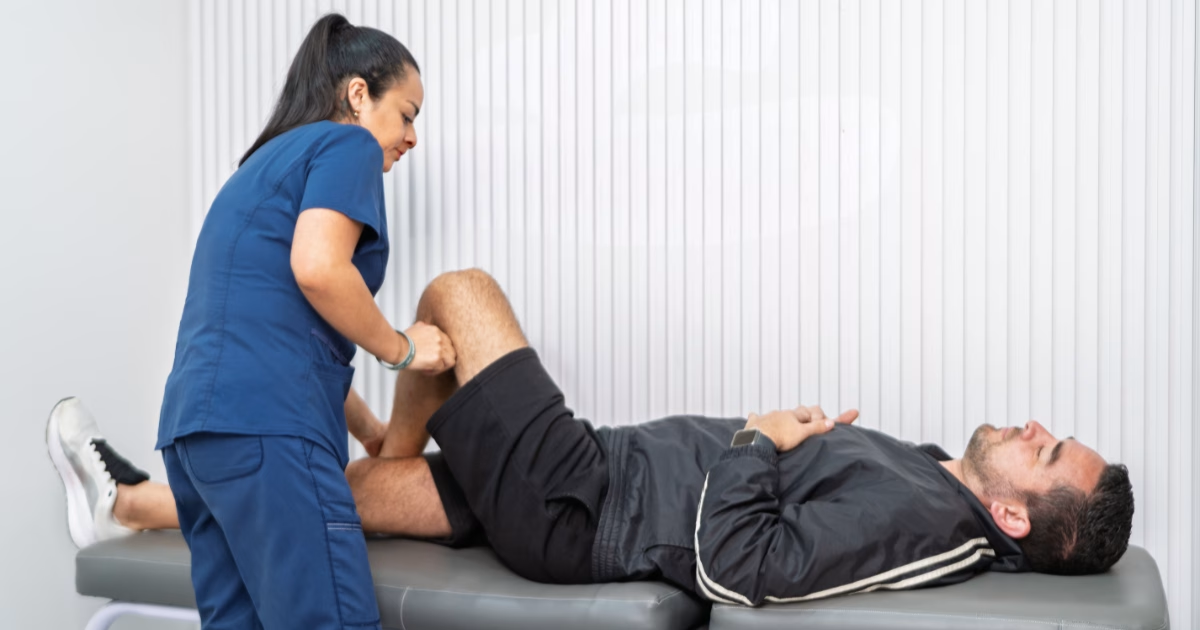Post surgery physiotherapy is essential for recovery, offering numerous benefits that aid in rehabilitation and restoring physical activity. At Movewell, our program focuses on effective strategies to enhance your post-operative healing and improve your overall physical well-being.
Understanding Post-Surgery Physiotherapy
Definition and Importance of Post-Surgery Physiotherapy
Post-surgery physiotherapy helps people recover after surgery. This kind of therapy is very important for getting back on track. It helps patients regain their strength and movement. It also works on issues like pain or stiffness that might pop up while healing.
Why is post-operative physiotherapy so important? Well, engaging in physical therapy after surgery can speed up recovery. It means patients can return to their normal activities sooner. Plus, it improves their overall quality of life. Rehabilitation programs are designed just for each patient, focusing on their specific needs and goals.
Types of Post-Surgery Physiotherapy
There are different kinds of post-surgery physiotherapy. Each type fits specific surgeries:
- Orthopedic Rehabilitation: Helps with recovery from joint surgeries or broken bones.
- Respiratory Physiotherapy: Focuses on breathing better after chest surgery.
- Cardiac Rehabilitation: Aids those recovering from heart surgery, improving heart health with safe exercises.
Each type pays attention to what the patient needs based on their surgery and health status.
Benefits of Post-Surgery Rehabilitation
Joining a structured post-surgical rehabilitation program has lots of benefits:
- Pain Management: Good techniques can help lessen pain after surgery.
- Mobility Improvement: Special exercises make it easier to move around and stretch.
- Strength Restoration: Gradual workouts help rebuild muscle strength lost during rest.
These advantages not only help the body heal but also boost feelings of independence and confidence as patients get back to doing what they love.
Role of Physiotherapists in Post-Surgery Recovery
Physiotherapists play a key role in recovery after surgery. They start by assessing each patient’s individual needs. Then, they create a personal treatment plan with specific goals to guide recovery.
They know what exercises are best for each person’s condition and teach how to move correctly during everyday tasks. This expert support helps promote healing while encouraging independence throughout the recovery period.
Timeline and Procedures in Post-Surgery Physiotherapy
Post-surgery physiotherapy is key for healing after an operation. It helps people get stronger, move better, and return to their regular activities. Knowing the timeline and procedures can make recovery easier.
Timeline for Post-Surgery Physiotherapy
The timeline for post-operative physiotherapy changes based on the surgery type and each person’s needs. Usually, rehab starts right after surgery to support early recovery and avoid issues.
- Immediate Phase (Days 1-3): Right after surgery, physiotherapists help with gentle movements to stop stiffness. Patients might do breathing exercises or light stretches.
- Early Recovery Phase (Days 4-14): As healing continues, therapists suggest more organized exercises that help improve mobility and lessen pain. Having an individualized treatment plan is important here.
- Rehabilitation Phase (Weeks 2-6): This stage focuses on making muscles around the surgery site stronger while improving overall fitness through exercises that fit each patient’s needs.
- Late Recovery Phase (Weeks 6+): Once basic strength improves, patients start practicing movements that mimic daily tasks or sports activities as needed.
Every recovery program should adjust according to how well a person is doing, with ongoing checks from physical therapy experts.
Common Surgical Procedures Requiring Physiotherapy
Several surgeries often need orthopaedic physiotherapy:
- Joint Replacement Surgeries: Like hip or knee replacements where getting movement back is super important.
- Sports Injuries: After surgeries like ACL repair, there are specific rehab steps for athletes to get back to their game safely.
- Cardiac Surgeries: Cardiac rehab helps bring heart function back through supervised exercise plans.
- Pulmonary Surgeries: These surgeries usually require pulmonary rehabilitation that focuses on improving lung health using breathing techniques and appropriate physical activities.
Physiotherapists play a big role in guiding patients through these recovery processes effectively.
Individualized Treatment Plans and Goal Setting
Making a personalized treatment plan is very important for success in post-surgery physiotherapy. Patient-centered care means that each person’s special situation is taken into account when setting goals for recovery.
Importance of Tailoring Rehabilitation Programs
Personalized plans lead to better results by focusing on what each person needs after different types of surgeries:
- For joint replacement patients, a goal could be to regain full movement within six weeks.
- Athletes bouncing back from sports injuries might aim to follow a step-by-step return-to-play plan over several months with drills that build agility along with strength restoration efforts.
Having clear objectives designed specifically for each individual’s lifestyle keeps motivation high during recovery while encouraging active participation in therapy.
Factors Influencing the Timeline
Different things affect how fast someone recovers after surgery:
- Age: Older folks generally take longer to heal because of natural body changes and other health issues during recovery periods.
- Overall Health Status: Conditions like diabetes can slow down healing, leading to longer recovery times before hitting goals related to mobility improvement.
Understanding these factors helps everyone involved manage expectations about timelines linked to effective surgical rehab paths available!
Techniques Used in Post-Surgery Physiotherapy
Post-surgery physiotherapy helps patients recover and get back to their normal lives. Different techniques are used to make sure patients heal well after surgery. These include exercise therapy, manual therapy, electrotherapy, and hydrotherapy. Each of these techniques has a special job but they all work together to help with rehabilitation after surgery.
Exercise Therapy: Range of Motion, Strengthening, and Gait Training
Exercise therapy is super important after surgery. It includes recovery exercises that focus on:
- Range of Motion Exercises: These help the joints move better and stay flexible. Gentle movements can stop stiffness and boost blood flow.
- Strength Building After Surgery: This means doing exercises that slowly increase resistance. It helps rebuild muscles and improves physical function.
- Gait Training: Many patients need help learning to walk again after surgery. Gait training focuses on improving balance and walking skills.
Combining these exercises makes it easier for patients to gain independence as they heal.
Manual Therapy: Mobilization, Massage, and Soft Tissue Work
Manual therapy uses hands-on methods to ease pain and improve movement during orthopedic physiotherapy.
- Mobilization Techniques: Gentle movements can reduce pain and help joints move normally again.
- Massage Therapy: This helps relax tight muscles around the surgery area. Massage improves blood flow, which is key for healing.
- Soft Tissue Work: Focusing on muscles and fascia releases tension that can build up after surgery.
These manual therapy techniques are vital for reducing discomfort while promoting healing throughout the body.
Electrotherapy: Ultrasound, Electrical Stimulation, and Laser Therapy
Electrotherapy uses electrical tools to help manage pain after surgery.
- Ultrasound Therapy: Sound waves go deep into the tissues. This can lessen swelling and speed up healing.
- Electrical Stimulation (TENS): This method sends tiny electric signals to relieve pain by blocking messages that tell the brain there’s pain.
- Laser Therapy: Low-level lasers help cells heal faster by encouraging cell growth.
Using electrotherapy in a recovery plan offers new ways for postoperative pain relief without relying too much on medication.
Hydrotherapy: Aquatic Exercises and Heat/Cold Therapy
Hydrotherapy involves water-based exercises that use the properties of water for better mobility during recovery after surgery.
Water gives support which helps joints move without too much stress:
- Therapeutic Aquatic Exercises: Activities in water allow patients to move safely without hurting themselves.
- Heat/Cool Therapies: Heat before exercise increases blood flow; cold afterward reduces swelling—both are important for recovery strategies.
Overall, every technique used in post-surgery physiotherapy plays a role in different areas of care during this important healing time after surgery. By using these methods designed for each patient’s needs based on what kind of surgery they had, healthcare providers aim for successful long-term health recovery!
Managing Common Challenges in Post-Surgery Physiotherapy
Post-surgery physiotherapy is very important for a good recovery. Many patients face challenges during this time. Knowing how to handle these common problems can make a big difference in recovery.
Pain Management: Medications, Home Remedies, and Physical Techniques
Managing pain after surgery is really important. Patients often use a mix of medications and home remedies to help with discomfort.
- Medications: Doctors give pain relievers to help control pain after surgery.
- Home Remedies: Things like ice packs or heat pads can make you feel better at home.
- Physical Techniques: Gentle exercises in physical therapy can lower pain levels and help you heal.
By learning about these options, patients can find what works best for them during recovery.
Joint Stiffness and Scar Tissue Prevention
After surgery, joints can get stiff if not moved. It’s key to start exercises early on to avoid stiffness and help flexibility:
- Range of Motion Exercises: These movements keep your joints flexible without pushing too hard.
- Muscle Strengthening Activities: Building strength around the joint helps it work better.
Also, it’s important to prevent scar tissue. Techniques like stretching and gentle massage keep the tissues soft while healing.
Psychological Support and Motivation for Recovery
Recovering from surgery isn’t just about the body; it can be tough mentally too. Giving emotional support is important for keeping patients motivated:
- Counseling helps patients deal with feelings and learn ways to cope.
- Group sessions let people share their experiences, which can boost morale.
This focus on patient-centered care encourages individuals to stick with their rehab plans even when things get tough.
Dietary Considerations for Post-Surgery Healing
What you eat matters a lot when healing from surgery. A balanced diet with proteins, vitamins, and minerals speeds up recovery by giving the body what it needs:
- Protein-Rich Foods: Include lean meats, beans, nuts, and dairy for muscle repair.
- Fruits and Vegetables: They provide vitamins that help your immune system stay strong.
Talking to a nutritionist can help patients get advice that fits their specific health needs during recovery.
Addressing Mobility Rehabilitation Challenges
Many people find moving around hard after surgery because of swelling or weakness:
- Start with small activities each day to build confidence without getting hurt.
- Mobility training should focus on moving correctly over time while being safe under professional guidance.
These strategies lay a strong foundation for being active again after recovery!
Importance of Adherence to Treatment Plans
Following treatment plans closely affects recovery success:
- Taking part in guided recovery programs helps everyone stay on track toward their goals.
- Understanding why sticking to the plan matters helps patients take charge of their progress—leading them closer to getting better!
Personalized Approach to Post-Surgery Physiotherapy at Movewell
At Movewell, we know every patient’s recovery after surgery is different. Our way of doing post-surgery physiotherapy focuses on making individualized treatment plans that fit the unique needs and goals of each person. By using patient-centered care, we aim to make rehabilitation after surgery effective and comfortable for everyone.
Movewell’s Comprehensive Assessment and Evaluation Process
Before starting your rehab program, we first do a careful physiotherapist assessment. This process helps us understand your physical condition and look into your surgery history. We also check for any potential problems that could happen after surgery. Plus, we give pre-operative education to help you get ready for your surgery.
Our trained physiotherapists use different tools to measure things like strength, flexibility, and how well you can move. This helps us understand where you are before starting your recovery program.
Tailored Rehabilitation Plans for Individual Needs and Goals
After the assessment, our team creates an individual treatment plan just for you. Each plan is based on many factors like age, type of surgery, health status, and what you want to achieve.
These customized rehab plans not only focus on physical issues but also include ways to keep you motivated during recovery. Our goal is to help you reach small goals that lead to full recovery while making sure you’re comfortable during your therapy sessions.
Advanced Technology and Treatment Modalities
Movewell uses advanced technology in therapy sessions to make outpatient rehabilitation more effective. We have great equipment for exercises and use techniques like electrical stimulation or ultrasound therapy. These treatments are part of our holistic approach, which looks at both physical healing and emotional health.
By combining these technologies with traditional methods, we offer a complete experience that helps you recover faster while keeping you engaged along the way.
Patient Education and Home Exercise Programs
Learning about your recovery is key. At Movewell, we believe in giving patients the right information about their conditions through support services from our friendly team members.
We create personalized home-based rehabilitation exercises so patients can continue their progress safely outside of the clinic. These exercise prescriptions are designed for each person’s abilities—making sure they are effective but also fit into daily life easily.
Success Stories and Outcomes in Post-Surgery Physiotherapy
After surgery, physiotherapy is really important. It helps people get their strength and movement back. At Movewell, we’ve seen many amazing success stories. These stories show how early help and strong rehab can make a big difference.
Testimonials and Case Studies from Movewell Patients
At Movewell, we love sharing patient success stories. These stories show how our post-operative care helps people recover well. For example, a patient who had knee surgery felt much better after following their own rehab plan. They were thankful for the support they got while recovering. They said that physical therapy helped them get back to daily activities much faster than they thought possible.
Another patient had shoulder surgery and found it hard to move at first. But after a few weeks of regular therapy with special exercises, they got their full movement back. These care experiences highlight both individual success and the effectiveness of our methods.
Benefits of Early Intervention and Dedicated Rehabilitation
Getting help soon after surgery is key for a good recovery. Here are some benefits of early intervention:
- Better Mobility: Starting exercises right away helps you move better.
- Less Pain: Patients who begin rehab soon feel less pain.
- Faster Recovery: Quick action can lead to getting back to normal faster.
Dedicated rehab programs focus on each person’s needs right away. This helps avoid problems like stiffness or weak muscles, while also boosting overall health.
Importance of Adherence to Treatment Plans
Following a personalized treatment plan is very important for good results in post-surgery physiotherapy. When patients stick to their plans, they often recover quicker and have better long-term results.
Here’s why sticking to the plan matters:
- Empowerment: Following the program helps patients feel more independent.
- Adjustments: Regular check-ups let therapists change plans based on progress.
- Motivation: Staying engaged with the plan keeps spirits high during recovery.
Long-Term Outcomes and Maintaining Recovery
Good physiotherapy leads to lasting results over time. Many people notice improvements in their daily lives due to continued exercise even after formal rehab ends.
Here are some long-term benefits:
- Ongoing Functionality: People keep moving well as time goes on.
- Chronic Pain Relief: Many find ways to reduce pain that may last after surgery.
- Health Maintenance: Staying active helps prevent future injuries and supports overall well-being.
Staying proactive about exercise makes health goals reachable. It’s clear from many success cases that regular activity keeps you feeling good long after treatment ends at Movewell.







